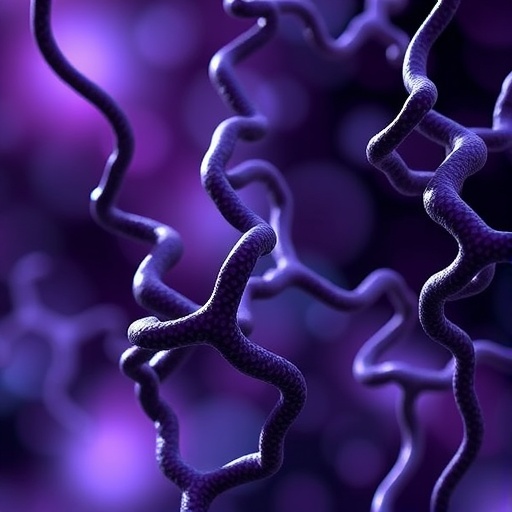In recent years, polyamines have emerged as fascinating bioactive molecules with dualistic roles in human physiology—simultaneously promoting healthy aging and driving cancer proliferation. These small organic cations, including spermidine and spermine, are ubiquitously present in all living cells and are involved in a variety of essential cellular processes such as growth, differentiation, and autophagy regulation. The paradoxical nature of polyamines has baffled researchers: while they have demonstrated clear benefits in longevity and cellular homeostasis, elevated polyamine levels are a hallmark of numerous aggressive cancers. A groundbreaking study led by Associate Professor Kyohei Higashi from Tokyo University of Science now offers critical insights into the molecular mechanisms underlying this enigma, revealing how polyamines selectively influence cancer progression via the protein eukaryotic translation initiation factor 5A2 (eIF5A2).
The study begins with a fundamental biological question: how do polyamines mediate their contrasting effects on healthy and malignant cells? Prior research has established that polyamines facilitate autophagy—a process that removes defective organelles and proteins—through activation of the isoform eIF5A1. This protein is indispensable for mitochondrial respiration and cellular health in normal tissues. However, cancer cells display a profound metabolic shift known as the Warburg effect, favoring aerobic glycolysis to fuel rapid proliferation. The current work addresses whether polyamines play a contributory role in orchestrating this metabolic reprogramming and, if so, through what molecular intermediaries.
Employing state-of-the-art proteomic methodologies, Dr. Higashi’s team analyzed over 6,700 proteins in human cancer cell lines after manipulating intracellular polyamine concentrations. By pharmacologically depleting polyamines and then reintroducing spermidine, the researchers could precisely dissect the impact of these molecules on protein synthesis and metabolic pathways. Intriguingly, instead of enhancing mitochondrial respiration as seen in healthy cells, polyamines predominantly stimulated glycolysis-related proteins in cancer cells. This observation shifts paradigms, signifying that polyamines actively rewire energy metabolism to support malignant growth.
Central to these findings is the differential regulation of two highly homologous proteins: eIF5A1 and eIF5A2. Despite sharing 84% amino acid sequence similarity, their functional distinctions are profound. While eIF5A1 activation aligns with beneficial autophagic pathways, eIF5A2 is upregulated specifically in cancer cells. Elevated eIF5A2 expression was tightly correlated with increased synthesis of ribosomal proteins such as RPS27A, RPL36AL, and RPL22L1, which have known oncogenic associations. This selective translation regulation hints at a cancer-specific program driven by polyamine-mediated eIF5A2 that promotes tumor progression.
Delving deeper, the study elucidated the regulatory circuit controlling eIF5A2 production. Normally, a microRNA molecule known as miR-6514-5p suppresses eIF5A2 translation, thereby maintaining low baseline levels of the protein in non-cancerous cells. However, polyamines disrupt this suppression, effectively lifting the translational blockade and enabling increased eIF5A2 synthesis. This novel mechanism provides a direct link between metabolic status, translational control, and oncogenic potential. It exemplifies how subtle RNA-mediated checkpoints can be subverted in pathological contexts.
The ramifications of these findings are profound for both therapeutic development and the broader understanding of aging biology. Polyamine supplementation has been widely touted for its anti-aging properties, given its ability to stimulate mitochondrial autophagy and enhance cellular resilience. Nonetheless, these new insights warn against indiscriminate use of polyamine boosters, as tissues harboring early precancerous changes might inadvertently fuel malignancy via the eIF5A2 axis. Therapeutic strategies will need to finely balance these opposing actions to harness polyamines’ benefits without triggering oncogenesis.
Importantly, the research paves the way for novel targeted cancer therapies. By focusing on the protein synthesis machinery specific to cancer cells—namely, eIF5A2 and its interactions with ribosomal components—drug designers may develop inhibitors that selectively block tumor growth while sparing normal tissues. This cancer-selective vulnerability holds promise for higher efficacy and lower side effects compared to conventional cytotoxic treatments, which broadly impact dividing cells.
Moreover, this study underscores the critical significance of context-dependent molecular activities. The dichotomy between eIF5A1 and eIF5A2 exemplifies how paralogous proteins can attain vastly distinct biological roles through differential regulation, interaction networks, and cellular localization. Polyamines serve as metabolic signals that tip the balance between these isoforms, configuring a gene expression landscape compatible either with cellular longevity or malignant transformation.
The methodological rigor of the research deserves mention. The team’s use of quantitative proteomics to capture thousands of protein expression changes provides a systems-level view seldom achieved in cellular metabolism studies. Through integrated molecular biology techniques, including RNA interference and microRNA manipulation, they established causal relationships rather than mere correlations. Such comprehensive approaches elevate our mechanistic comprehension and open new investigative avenues into translational control in cancer.
In summary, the findings reported by Associate Professor Kyohei Higashi and colleagues represent a major advance in deciphering the dualistic roles of polyamines in human health and disease. By revealing that polyamines promote cancer cell proliferation via upregulation of eIF5A2 and associated ribosomal proteins—mechanistically distinct from the beneficial autophagic activation prompted by eIF5A1—this work resolves a longstanding biological paradox. The identification of miR-6514-5p as a key regulatory node further enriches our molecular understanding and supplies a promising therapeutic target for oncological intervention.
As research continues to unravel the intricate molecular interplay governing aging and cancer, this study highlights the necessity of precisely defining biochemical context before clinical applications. Polyamines, long admired as anti-aging compounds, must now be approached with careful scrutiny to avoid unintended oncogenic risk. Meanwhile, the selective vulnerability of eIF5A2-dependent translation in tumors offers a beacon of hope for next-generation cancer pharmaceuticals designed to outmaneuver malignancy at its metabolic core.
Subject of Research: Cells
Article Title: Polyamines stimulate the protein synthesis of the initiation factor eIF5A2 participating in mRNA decoding distinct from eIF5A1
News Publication Date: 1-Aug-2025
Web References:
Journal of Biological Chemistry Article
DOI: 10.1016/j.jbc.2025.110453
References:
Higashi K, et al. Polyamines stimulate the protein synthesis of the initiation factor eIF5A2 participating in mRNA decoding distinct from eIF5A1. Journal of Biological Chemistry. 2025 Aug 1;301(8).
Image Credits:
Dr. Kyohei Higashi, Tokyo University of Science, Japan
Keywords
Biochemistry, Molecular chemistry, Molecules, Physiology, Senescence, Cellular senescence, Human health, Clinical research, Cancer research, Molecular biology, Biomolecules




